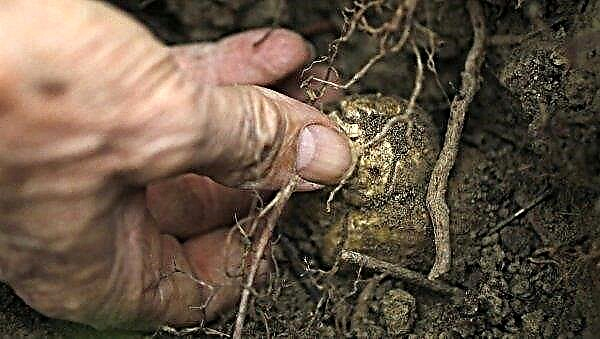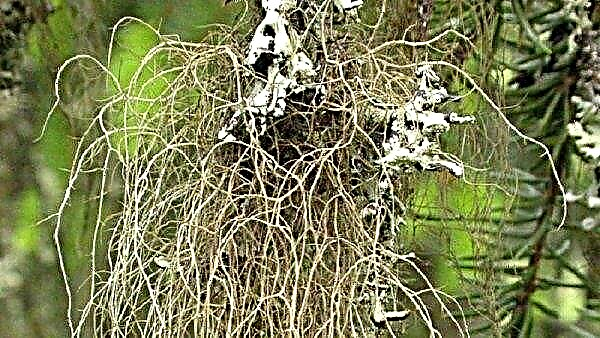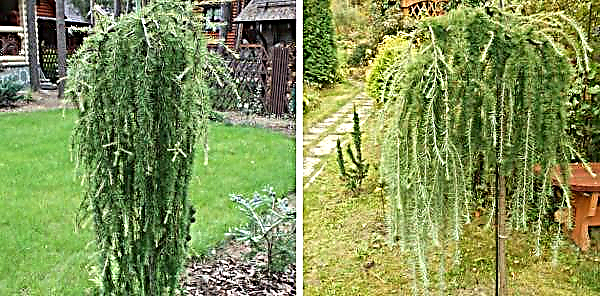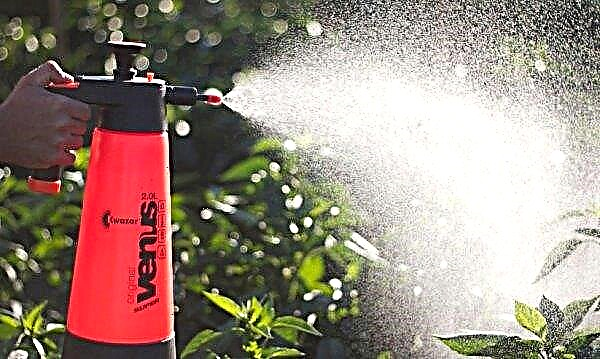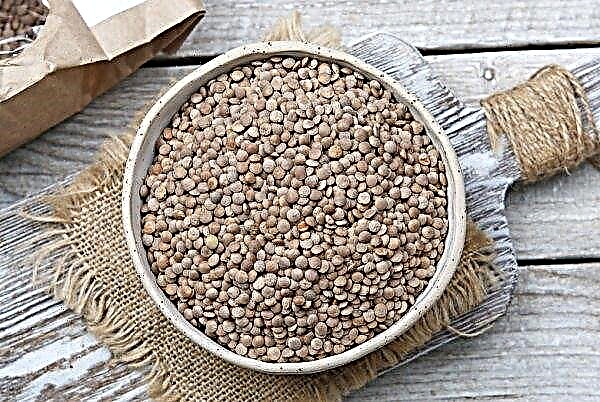Some diseases of garden plants, at first glance, do not seem critical. Inexperienced gardeners may not pay attention to spots or plaque that appeared on the bush with tomatoes. If you do not start the fight against these spots in time, the plant may die, and you will be left without a crop. This is how treacherous cladosporiosis behaves, which is considered the most dangerous disease for tomatoes. What is this disease, and how to cope with it - we will tell further.
What is tomato cladosporiosis?
The description of the ailment is simple - a fungal infection. Infects the plant at the bottom, gradually moving to the top. At first, the signs of the disease appear only on the leaves, but if the fight is not started on time, it will affect both the stem and the fruits. Conidia, immovable spores, are easier than the spores of ordinary fungi, so the speed of their spread is higher.
Folk cladosporiosis is called brown or olive spotting due to the color of the spots.
Did you know? Cladosporium belongs to imperfect fungi. They were able to spread to all six continents and attack not only the plant world, but also people.
Causes and pathogens
The cause of the disease is the fungus Cladosporium fulvum. Its main feature is to maintain vitality for up to 10 months. He is not afraid of freezing temperatures and drought. Infection occurs when spores fall on a bush. They are light as dust, so you can distribute them in any way. Most often this happens when watering or loosening the earth, when you touched a sick plant with a working tool, and then moved to a healthy one.
Infection occurs when spores fall on a bush. They are light as dust, so you can distribute them in any way. Most often this happens when watering or loosening the earth, when you touched a sick plant with a working tool, and then moved to a healthy one.
Therefore, it is necessary to monitor the appearance of tomato bushes. In addition, even if you overcome the disease, spores can remain on the instrument until the next season, so you need to pay attention to and disinfection of garden tools.
Signs of infection
More often, greenhouse tomatoes suffer from the disease, but the ground ones are not immune from the attack of cladosporiosis. It manifests itself when the plant begins to bloom.
Signs:
- light green spots appear on the lower leaves on the front side without clear contours;
- the back of the foliage is covered with a light gray coating, over time, the color changes to yellow-brown or green-brown;
- diseased foliage gradually dries and falls;
- if the disease began to rise up, then round black hollows with a velvety coating may appear on the fruits.
Important! If the signs of the disease are noticeable in the upper part of the plant, then spores have ripened from below, on the affected leaves, and are ready to move to a new «the owner». Therefore, to begin the fight against cladosporiosis should be as early as possible.
What is the danger of cladosporiosis?
Affected foliage dries and falls. The more leaves a plant loses, the more difficult it will be to perform photosynthesis. There will be less nutrients, which means that the plant will not have the forces to bloom and form the ovary. In addition, if the ovary was able to form, but the fungus attacked the fetus, it was not destined to ripen. As a result, significant losses in the crop.
In addition, if the ovary was able to form, but the fungus attacked the fetus, it was not destined to ripen. As a result, significant losses in the crop.
Methods of controlling and treating cladosporiosis on tomatoes
The fight against the disease is carried out in four ways:
- Chemical.
- People’s.
- Mechanical.
- Biological.
Read about what to treat and how best to deal with cladosporiosis.
Chemicals
Chemical preparations are recommended to be carried out when it was not possible to save the plant with the help of other means, since chemicals accumulate in the fruits, and then, when consumed, they enter the human body.
Important! When working with chemical preparations, all safety measures must be observed so that the substance does not get on a person.
A number of fungicides are usually used to eliminate olive spotting:
- Abiga Peak - 50 g per 10 liters of water, treat the plant three times with an interval of 20 days.
- "Bravo" - 3 liters per 1 ha (consumption of fungicide), 400-600 liters per 1 ha (consumption of working substance). The first treatment is carried out as preventive, if during the growing season favorable conditions for the manifestation of the fungus have developed. The next two - with an interval of 7-10 days.
- "Poliram" - consumption of 6 liters per 1 ha. Three sprayings should be carried out. The first - with the beginning of flowering, the second - before the formation of the ovary, the third - between them.
- Home - 40 g per 10 liters. When spraying, it is necessary to spend 10 liters per hundred square meters. Processing is carried out during the growing season. For the period you need to carry out 4 treatments.

Folk remedies
They do not help much in the fight against olive spotting. They are used when the ailment has just begun to manifest itself.
Popular recipes for remedies for fungus:
- Iodine chloride. 0.03 kg of potassium chloride is diluted in a bucket of water and 40 drops of iodine are dripped. The bush is watered with a solution and sprayed. The soil must necessarily get wet by 0.1 m.
- Serum. 1000 ml of the product is diluted in 10 liters of water. The mixture is thoroughly mixed and poured under the bush.
- Serum and iodine. 25 drops of iodine are dripped into a liter of serum. The mixture is diluted with water up to 10 liters. Plants are sprayed with it.
- Potassium permanganate. Water is mixed with potassium permanganate to a pink color. No solid particles should remain in the solution. Used for spraying crops.
- Wood ash. A glass of sifted ash is poured with a liter of water, boiled for 30 minutes, cooled and used for spraying and watering bushes.
Mechanically
This method involves pruning the affected foliage, regularly ventilating the greenhouses and increasing the interval between plant irrigation (up to 7 days). To exclude the probability of the spread of spores, the soil is covered with a dark plastic film.
Foliage is removed carefully. In the process, a plastic bag is used, which covers the diseased foliage, and then breaks into this bag.
Biological method
Biological products, unlike chemicals, are not able to penetrate into the fetus and accumulate in it, but they have a less aggressive effect on pathogens. They are easily washed off when watering or during rain, so the treatment must be carried out being sure that another day of precipitation is not expected.
- "Fitolavin 300". The product is diluted in an amount of 20 ml per bucket of water. When spraying, 2 l of the product should go to the bush. Processing is carried out twice, with an interval of 14 days when only the manifestation of the disease is noted.
- "Fitosporin." 5 grams of powder are diluted in a bucket of water. The foliage is sprayed with an interval of one and a half to two weeks two to three times. The drug is also suitable for the treatment of greenhouses, soils.
- "Pseudobacterin-2." Consumes 10 liters per 1 ha. It is used during the growth period twice with an interval of 20 days.
Important! Some experts believe that the ideal option would be to remove the diseased bush and burn it, so that the spores do not spread throughout the site.
Preventative measures
Olive spotting refers to diseases that are cheaper to prevent than to fight them.
As a preventative measure, we recommend the following:
- ventilate the greenhouse often;
- remove diseased foliage from below the bush in time;
- disinfection of the greenhouse and soil at the beginning and end of the season;
- cleaning the beds of crop residues and burning them;
- to keep humidity in the greenhouse at the level of 60–70%, and the temperature at +18 ... + 20 ° С;
- daily inspection of plants;
- planting seedlings strictly according to the scheme;
- carry out seed disinfection;
- prevent soil from getting stuck;
- watering bushes only early in the morning or late in the evening;
- periodic treatment of plants with biological preparations.
Varieties of tomatoes resistant to cladosporiosis
Breeders managed to develop varieties resistant to cladosporiosis:
- Our Masha F1;
- Space Star F1;
- Vezha;
- Giant;
- Pink Paradise F1;
- Vitador F1;
- Swallow F1;
- Pinky F1;
- Business Lady F1;
- Pink Magic F1;
- Paradisaic delight;
- Malika F1;
- Black Moor;
- Cherry Ira F1;
- Admiralteysky;
- Red cherry;
- Titanic F1;
- Gardener;
- Red Comet F1;
- Victoria F1;
- Torbay F1;
- Centaur F1;
- Octopus F1;
- Delicacy
- Funtik;
- Eupator.
 Olive spotting of tomatoes can cause a lot of trouble to agronomists and reduce productivity.
Olive spotting of tomatoes can cause a lot of trouble to agronomists and reduce productivity.Did you know? Wild tomatoes grow in South America. They give fruits weighing 1 gram.
To fight the disease, you must begin by discovering the first symptoms. But it is better to carry out preventive measures to avoid such problems.

